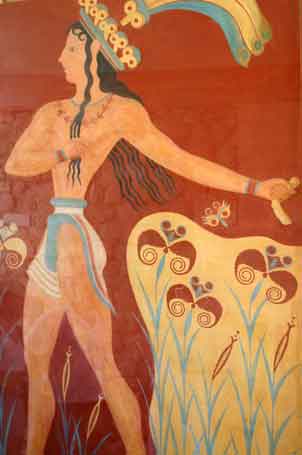Do searches on the following words:
Minoan
labrys
The figure of the man, particularly the way the shoulders and arms are portrayed look like figures in Minoan art. This "straight on look" is very common in earlier art (Egyptian, early Greek, etc), and it wasn't until much later in Greece that more realistic representations of the human figure began. As well, check out the hairstyle with the side braid and flowing hair over the shoulder.
On the other side, the motif looks like a double headed axe (labrys) which was a sacred sympbol of these people and is a common motif in artwork from the period. There are a number of references of amulets with a double headed axe of this time that were worn possibly as a charm to attract women (let us know if it works!

)
replica of a minoan axe
axe motif on vase
The Minoans were a civilization in the Mediterannean somewhere between 3,000 to 5,000 years ago. This civilization existed long before the Greeks and Romans, and many of Homer's famous stories about Hercules and the labarynth, possibly even Atlantis were based on these people. They were known traders traveling far and wide and their civilization was considered the center of the world at the time.
http://en.wikipedia.org/wiki/Minoan_civilization
"The Aegean bronze age civilizations established a far-ranging trade network. This network imported tin and charcoal to Cyprus, where copper was mined and alloyed with the tin to produce bronze. Bronze objects were then exported far and wide, and supported the trade. Isotopic analysis of the tin in some Mediterranean bronze objects indicates it came from as far away as Great Britain.
Knowledge of navigation was well developed at this time, and reached a peak of skill not exceeded until a method was discovered (or perhaps rediscovered) several thousand years later."
There has been on again off again speculation that the early Mediteranneans and later the Norse Vikings had trade routes that stretched as far as North America.
You might want to consider contacting someone who studies ancient civilizations at a nearby university. Although the language of the Minoans has not been decyphered, there are many examples of it on pottery and art work. There are symbols on your piece that someone might recognise immediately.
Wow. That is a very interesting find, Danimal. There are people who should be able to give you a much better idea, and possibly test it for age and origion. If you are able to find out more, please let us know!





